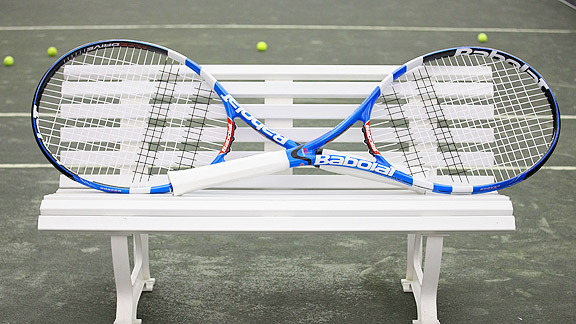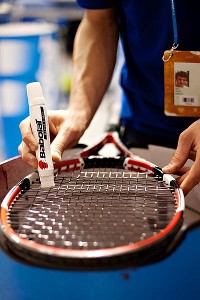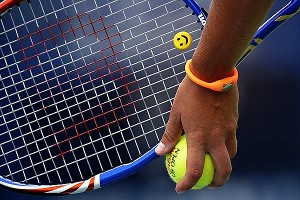 Ben Hider/Getty ImagesFor the longest time, racket technology outpaced the strings. Not anymore.
Ben Hider/Getty ImagesFor the longest time, racket technology outpaced the strings. Not anymore.More than anyone, Toni Nadal has always understood the subtle weaknesses of his sublimely talented nephew.
Which is why several years ago, chatting with Jean-Christophe Verborg, Babolat's international tour director, Uncle Toni asked for some assistance.
"Rafa is going to get older and older," he told Verborg, "so we have to help him a little bit."
Rafael Nadal already had won four straight French Open titles, plus another at Wimbledon. He was 22. But he had been playing with the same old-school polyester Babolat Duralast 15L strings for nearly a dozen years.
Verborg first approached Rafa with the company's red Revenge string, but because Nadal was the No. 1-ranked player in the world -- and famously superstitious about virtually every element of his game -- he said he didn't want to change anything. In 2009, pushed by Toni to come up with a little more "pump, a little more spin," not to mention a few more free points on the first serve, Verborg's engineers created a new, sleek black string.
When the ATP World Tour came to Paris, in November 2009, Verborg invited Rafa and Toni to Babolat's headquarters in Lyon, France.
"Come out to the factory," Verborg said. "Give me one hour. Let's try it. If you no like, OK. You like, could be interesting."
String is the (new) thing
Verborg, lounging at Babolat's hospitality site at Roland Garros, laughed. Wearing stressed jeans and a gray jacket, accented by a scarf, Verborg clearly enjoyed telling this story. At the time, though, he wasn't sure if there would be a happy ending, much less a global marketing phenomenon.
"The string," he insisted, "is as important as the racket. If you have a good racket -- and bad strings -- it's still bad."
This is true of concert-quality violins, and it's true of the modern sticks tennis professionals carry into battle. These days the string, many agree, is quite the thing.
Although the graphite racket technology has flattened, rather like the world economy, recent advances in strings have utterly changed the game. They have names such as Luxilon ALU Power, Technifibre's Black Code, Prince's Poly Spin 3D, Head's Sonic Pro -- and, of course, Rafa's black string: Babolat's RPM Blast.
Back in the day of wood rackets, natural gut was the string of choice. With today's synthetic polyester strings, which players can combine with gut for a hybrid string arrangement, they can hit shots that Borg and McEnroe never dreamed of. Athletes are stronger than their predecessors, and that strength is rewarded. Instead of the gentile, one-foot-forward, weight-transfer-from-back-to-front classic forehand, players now open their stance and hit the ball nearly as hard as they can; their follow-throughs can actually wind up behind them. Employing an extreme western grip, they can impart severe torque, causing the ball to spin ferociously. Elite players play a more vertical game than club players, so their aggressive swipes maintain unprecedented speed, yet still manage to find the court.
In other words, power and speed have increased without compromising control.
"When you have the ball in the string bed, there is a very good flexibility," Verborg said. "You have a feeling of the ball. You are thinking, 'I know where I am sending the ball.' "
Sounds like a deal with the devil, doesn't it?
"The players tell us they can swing with everything they have and, in the last 25 percent of the flight, the ball disappears onto the court," said Ron Rocchi, Wilson's global tour equipment manager. "[Roger] Federer and Nadal can create angles from the baseline that didn't exist four, five years ago. They can hit a ball three feet off the service line and see it bounce into the stands."
Tennis, at a distance, is a lovely, lyrical dance. Up close, though, the collision between ball and racket is disturbingly violent. Not unlike the gruesome slow-motion shots of gun fights by western director Sam Peckinpah.
Viewed at a few frames a second, you can see the flexed wrist and arm muscles of the player absorbing the blow -- while moving aggressively through the ball -- the racket head bending, chattering tremendously, the ball (typical groundstrokes for professionals average between 70 and 90 miles per hour) diving into the string bed, deforming and compressing into an astonishingly small yellow bit of rubber, the strings giving way until they reach their limit and snap back, spitting the ball out like a cannon.
It looks a lot like anarchy. The Babolat cameras used in research were actually developed for ballistics tests. The whole exchange takes about four-one-hundredths of a second. And yet that brief kiss between string and ball defines the entire arc of the shot.
Eric Babolat is the fifth-generation CEO of Babolat. He learned the business from the bottom up, stringing rackets at Grand Slams. His great-great grandfather founded the company that invented gut strings in 1875.
"The string is part of the racket and the racket is an extension of their body," he said, smiling. "There is lots of psychology involved."
Keeping it in the park
Fabrizio Sestini was an All-American at TCU, but he's also a solid post player in pickup basketball games at the ATP World Tour headquarters in Ponte Vedra Beach, Fla.

He's a tour manager for the ATP and spends a lot of time around the players and their equipment.
"Strings are a vital part of the equation, probably the second-most important aspect after the racket," Sestini said. "The comparison I would make is a downhill skier and the wax on his skis. They arrive at a level where they are so sensitive that they can feel if their string tension is a half a kilo more or less than usual.
"They are very, very picky. Sometimes, from the outside, it would look like they are crazy."
For the longest time, racket technology outpaced the strings.
"That was the problem," Rocchi said. "And then the polyester strings caught back up to the rackets. I thinkAndy Roddick was one of the first guys to go with a wide-body racket and 16 mains, an open string pattern. Before that, everybody played with a dense pattern. Guys would try rackets and the ball would fly off them. There was no way to tone it down."
No way to keep the ball in the park. Polyester strings changed that.
The watershed event was Gustavo Kuerten's victory at the 1997 French Open. The 20-year-old Brazilian credited his Luxilon strings for allowing him to hit the ball harder and impart greater spin. By the time he won his next two titles at Roland Garros, in 2000-01, the buzz over polyester strings was deafening.
Todd Martin, a two-time major finalist, has an exquisite tennis memory. He gave two examples of the breakthrough from his perspective. The first came at Roland Garros in 2002 when he was playing Alex Corretja in a second-round match.
"I was getting my clock cleaned," Martin remembered. "I served and volleyed out wide in the ad court and I hit a very good serve. Alex just got the return back, and I hit a forehand volley. I didn't angle it great, but it got on him pretty fast. I thought it was 50-50 that he would get his racket on it. He made a good play on it; late but a lot of racket. I'm thinking people in the first row on the side of court are in danger.
"The ball left the racket and missed only by four feet -- not the four meters I had guessed. It was shocking to me how much that ball moved considering how fast he hit it. It was alarming, and it was all strings."
Tweet, tweet
Don't miss a moment of the latest tennis coverage from around the world. Follow us on Twitter and stay informed. Join »
Two years later, Martin was practicing with Thomas Enqvist at Roland Garros and both men, Martin says, were using Luxilon strings.
"We went out to hit, and 10 minutes in, we realized we had gone through our entire batch of six, eight balls," Martin said. "We were hitting it hard -- and we weren't missing. With regular strings, if you wanted to take the baseline out of play [by spinning the ball], Thomas and I would have had to change our swing patterns.
"If my normal forehand stroke [with gut strings] produced an arbitrary, say, 100 revolutions per second, my same forehand with half Luxilon and half gut would produce maybe 200 revolutions. That's a big difference. Plus, you get more forgiveness on off-center shots when you're not clean."
Fabrizio Sestini laughed when he heard the Martin stories. They play frequently; Martin lives near ATP headquarters.
"Todd is a great example because he didn't even know what topspin was -- he hit the ball so flat," Sestini said. "He hits with the same style, so I try to use the topspin when I can see he's in trouble."
Stringing them along?
Rafa accepted Jean-Christophe Verborg's invitation to the Babolat factory. In fact, he met with the engineers and technicians and practiced in Lyon before the Paris indoor tournament in November 2009 using the new black string. Verborg, who had a new product line -- and the potential riches that can come with it -- riding on Rafa's test sessions, was a nervous mess.
"Rafa comes off the court and says, 'Um, hmm … not bad,'" Verborg remembered. "And when a player says not bad, well …"
Verborg slapped his palms together.
"& is good, no?"
Uncle Toni texted Verborg when Rafa arrived in Paris and told him the testing had gone well.
"He likes the strings," Toni wrote. "We'll try them."
Playing with the RPM Blast string, Nadal was knocked out of the 2010 Australian Open quarterfinals. He had now gone four straight Slams without reaching a final (missing Wimbledon the year before), his longest such streak in six years.
After the RPM Blast product line had been launched, amid much fanfare, Rafa sought out Verborg.
"I don't know if I play well with these strings," Rafa told him.
There would be one more chance for the black string: Monte Carlo, the official beginning of the clay-court season.
Impact on the game
The synthetic strings have helped turn tennis into a passive-aggressive game. You can actually watch the elite players sometimes take a few quick steps backward when returning serve -- and then swat a winner from what looked like a defensive position.
"You see it happen all the time," said ESPN analyst Darren Cahill. "The strings have made it a more offensive game, especially from the baseline."

They also have placed a premium on retrieving ability. Perhaps the best two defenders in the game --Novak Djokovic and Caroline Wozniacki -- are the No. 1-ranked players on the ATP World Tour and WTA circuits. This is not a coincidence.
"The court is bigger," Martin said, "because the technology and skill of the players promoting just ungodly amounts of top spin -- without sacrificing pace on ball. The effect is that the court has become much wider than it used to be. More balls are in play and they are tougher to reach.
"As a result, lateral movement is more important now than it's ever been."
Last month, on learning that a string story was in the works, Mary Carillo started a stream-of-consciousness series of headlines that our tennis editor will no doubt attempt to steal:
A salute to strings.
String theory.
Super string.
Silly string.
"The string technology," the NBC and Tennis Channel analyst said, still cackling, "has created remarkable angles and amazing usages on the court. But the string giveth and taketh away. The one thing it's abolished is the net game. The ball just jumps around so much, it's hard to volley, hard to come in and attack the net against that level of spin and pace.
"John McEnroe has tried it -- his volley is so compact -- it kept him from feeling entirely comfortable. There's not as much variety as there used to be, which is why Djokovic is No. 1. He does everything better than everyone else from the baseline."
Brad Gilbert, who coached Andre Agassi, Andy Murrayand Roddick, keeps up with all the advances in technology. He owns a tennis shop near his home in northern California.
"I was hitting with a junior today, 16," Gilbert said. "He's been playing with these strings since he was 12. The younger generation has grown up with the technology and they're used to taking that big cut."
Gilbert does not mourn the death of the volley.
"Absolutely not," he said. "The strings take nothing from game. The people saying 'Go back to wood.' Well, that's just antiquated. Football was beautiful in the '70s, but we're playing a different game now.
"Same with tennis. I like what we're doing."
Secret sauce
There is a lot of intrigue surrounding the composition of strings. You might call it a tension convention. The proprietary blends that go into synthetic strings are guarded like the recipe for Kentucky Fired Chicken, the Big Mac and Coca-Cola.
Player preferences are not so closely guarded.
The Luxilon folks say that, based on stringing logs from the U.S. Open and Australian Open, player sponsorships and purchases, 73 percent of the ATP's top 100 use their strings, as well as 59 percent of the WTA's top 100.

One of those players isRoger Federer. He uses Wilson natural gut in the 16 mains, according to Wilson's Rocchi, strung at about 50 pounds of pressure, with synthetic Big Banger ALU Power Rough for the 19 crosses, at around 46. Most players string their rackets the opposite way, with synthetic strings in the mains and gut for the crosses. Djokovic, too, goes with gut in the mains and polyester in the crosses, but employs a higher tension on his larger racket, usually between 59 and 61 pounds. Djokovic uses a denser string pattern, 18 mains and 20 crosses. In theory, the more open string pattern allows players to produce more spin on the ball; Djokovic typically hits the ball flatter than either Nadal or Federer.
Nadal generally prefers an average of 55 pounds for all of his strings, but like Federer and Djokovic, he is quick to adjust when conditions change. Nadal goes into each match with eight freshly strung rackets. He changes every seven games, when new balls come out, but if he's due to serve he will play an eighth game. If the opponent is serving, he switches.
Another byproduct of these synthetic strings is that racket tensions have, generally speaking, come down in recent years.
"The average player has to understand they should lower tension with these products," Riocchi said. "A good rule of thumb is 10 percent. If you're playing with gut at 60, 55 with synthetic strings should give you a comparable feel. It's a mistake a lot of shops make, and when they're strung too tight a club player will feel like it's too firm."
Cahill thinks string tensions have come down about 10 pounds from the days when he was playing.
"Bjorn Borg strung his wooden racket so tight the strings would pop in the hotel room at night," Cahill said. "[Thomas] Muster used a racket like a board. With these strings and a looser racket, guys can put the ball anywhere they want."
A fine line
Toni Nadal is a successful tennis coach, but in the hands of clever producers, he's actually a decent actor. In opening scene of a Babolat commercial, Toni sits comfortably and speaks a serviceable French with English subtitles.
"At the time, he wasn't playing very well," Toni says of the search for a new string. "The racket is great, but &"
And then he raises his eyebrows and smiles coyly.
"In fact," Toni says, producing a 40-foot reel of 16-gauge (1.30 millimeters) RPM Blast, "his secret is this string."
The black, eight-sided string is described in Babolat literature as a "high-density co-polymer polyester monofilament combined with a new cross-linked coating."
As we now know, RPM Blast passed the Rafa test. The critical mass came at the 2010 Monte Carlo event, in which Rafa dropped only 14 games in a minimum 10 sets to win the title. He followed up with wins at Rome and Madrid, beating Federer in the final.
"Thank goodness," said Eric Babolat, the company's CEO. "The players' feeling is the key with these strings. It's not a mathematic formula. It's a fine line, sometimes you change something and you lose something."
This time, Rafa found something.
And so, he finished the 2010 season with three Grand Slam titles in a row, something Federer never did in the same calendar year. It was one of the greatest seasons ever.
Today, according to Babolat, about 20 percent of the elite players on the ATP World Tour and WTA use the RPM Blast string.
Toni Nadal, the pitchman, continued.
"It helped Rafa hit the ball harder, more topspin, while maintaining control," he said with a look of conviction. "Babolat made an amazing string. So we're very happy."
Courtesy: ESPN
No comments:
Post a Comment